|
|
Research Progress in Novel In-situ Integrative Photovoltaic-storage Tandem Cells
YU Shouwu, ZHAO Zewen, ZHAO Jinjin, XIAO Shujuan, SHI Yan, GAO Cunfa, SU Xiao, HU Yuxiang, ZHAO Zhisheng, WANG Jie, WANG Lianzhou
2020 Vol. 35 (6): 623–632
 Abstract
Abstract(
875 )
 HTML
HTML(
54)
 PDF
PDF(6994KB)(
1576
)
As smart electronic products are increasingly applied in our daily life, there is not only an increasing demand for high-performance photovoltaic power generation devices, but also strong need for in-situ energy storage functions in these devices. The integration of energy generating components and energy storage components into one device has become an attractive challenging technology. The basic idea is that by integration design and engineering the assembly of the photoelectric conversion layer and the energy storage layer into one in-situ energy conversion and storage system could not only offer multiple functions, such as self-powered ability, weak light buffer and portability, but reduce sunlight fluctuation effect on energy output. This review summarizes the research progress in novel in-situ integrative photovoltaic-storage tandem cells, classified by silicon solar cell, sensitized solar cell and perovskite solar cell. Evaluation of methodology, operational principle, construction feature, and performance parameter are also discussed and critically reviewed, and the further development of in-situ integrative photovoltaic-storage tandem cell is also prospected.
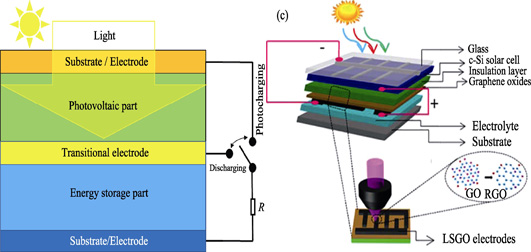
|
|
|
Electrocaloric Effect of Lead-free Bulk Ceramics: Current Status and Challenges
YU Ying, DU Hongliang, YANG Zetian, JIN Li, QU Shaobo
2020 Vol. 35 (6): 633–646
 Abstract
Abstract(
1253 )
 HTML
HTML(
37)
 PDF
PDF(3427KB)(
1543
)
Solid-state cooling technology based on the electrocaloric (EC) effect is attracting increasing attention as an important alternative for traditional cooling systems because of its advantages of high efficiency, environmental friendliness, light weight, low cost, and easy miniaturization. Ferroelectric materials are suitable candidates for EC refrigeration due to their large polarization and entropy change through applying or removing an external electric field. Recently, study on the EC effect of lead-free bulk ceramics has become one of hot topics on ferroelectric community due to the requirements of sustainable development. In this review, we firstly introduce the significant history events in EC research and the basic principles of EC refrigeration. Then, design strategy for achieving a large EC temperature change near room temperature and a wide using range is summarized. Subsequently, we systematically review the research status of EC effect in BaTiO3-based, Bi0.5Na0.5TiO3-based and K0.5Na0.5NbO3-based lead-free bulk ceramics and discuss their advantages as well as challenges. Finally, we propose some prospects for the future work on EC effect in lead-free bulk ceramics.

|
|
|
Progress on Phosphorene for Photocatalytic Water Splitting
ZHENG Yun,CHEN Yilin,GAO Bifen,LIN Bizhou
2020 Vol. 35 (6): 647–653
 Abstract
Abstract(
1015 )
 HTML
HTML(
32)
 PDF
PDF(1943KB)(
1168
)
Semiconductor photocatalytic water splitting has been considered as a potential strategy to overcome global energy shortage and environmental pollution. In recent years, phosphorene (BP) attracted great attention in photocatalytic water splitting due to its adjustable band gap, high hole mobility and wide absorption spectrum. This review summarizes the recent significant advances on designing high-performance BP-based photocatalysts for water splitting. The synthetic methods and modification strategies (e.g., surface modification and heterostructure design) of BP-based photocatalysts are described. Furthermore, in order to elucidate the structure-activity relationship of BP-based photocatalysts, the charge transfer mechanism is illustrated. Finally, the ongoing challenges and opportunities for the future development of BP-based photocatalysts in the exciting research area are highlighted.
|
|
|
Effect of Ablation Surface Microstructure on Plasma Arc Ablation Properties of C/C Throat Insert Fabricated via CVI+HPIC Methods
WU Xiaojun,YANG Jie,ZHENG Rui,ZHANG Zhaofu,YANG Yi
2020 Vol. 35 (6): 654–660
 Abstract
Abstract(
607 )
 HTML
HTML(
19)
 PDF
PDF(3623KB)(
764
)
The C/C composite was prepared by chemical vaper infiltration (CVI) followed by pitch impregnation and high pressure carbonization (HPIC) using needled non-woven carbon fiber felt preform. The microstructure of composites was characterized by micro-computed tomography (μ-CT) and scanning electron microscope (SEM). The ablation resistance at different cross sections was evaluated using plasma ablation test. Typical cross sections of the experiment were X-Y section (0°, perpendicular to needing direction), Z section (90°, parallel to needing direction) and cross sections (23°, 45°, 68°) of composites, respectively. The results presented that the porosity of the C/C composites was as low as 4%, and 98% of the internal pores was smaller than 20 μm. The ablation resistance at different cross sections improved first and then decreased from X-Y section (0°) to Z section (90°). The cross section at 68° showed the best ablation resistance, at which the mass and linear ablation rates were 0.050 g/s and 0.056 mm/s, respectively. The best ablation resistance is attributed to the icicle-like ablation mode of carbon fiber, which indicates that fiber arrangement at the cross section has significant impact on ablation resistance of C/C composites.

|
|
|
NiFe2O4 Ceramic U-shaped Sleeve Prepared by Slip Casting and Pressureless Sintering
ZHANG Zhigang,LU Xiaotong,LIU Jinli
2020 Vol. 35 (6): 661–668
 Abstract
Abstract(
440 )
 HTML
HTML(
7)
 PDF
PDF(5848KB)(
662
)
Slip casting and pressureless sintering were used to produce NiFe2O4 ceramic U-shaped protection sleeves for thermocouple in aluminum electrolysis. The stability of slurry, sintering behavior of green body as well as the temperature measuring performances, were investigated in detail. The Zeta potential of slurry was improved effectively by adding 10wt% NiFe2O4 nanopowders and 5wt% nano-binder, and the slurry possessed better sedimentation stability when pH was in the range from 10.0 to 11.0. Green bodies began to shrink significantly when the sintering temperature rising to 1100 ℃. The linear shrinkage and linear shrinkage ratio increased with temperature, and the linear shrinkage ratio reached its maximum at 1300 ℃. The sintering activation energy of the initial stage was 295.11 kJ·mol -1, and the main transport mechanisms were volume diffusion and grain boundary diffusion. The temperature testing results showed that the assembled thermocouple with NiFe2O4 ceramic protection sleeves worked well with timely response to temperature variation, as well as good resistance to thermal shock and corrosion from melt salts, with the prospect of industrial temperature measurement applications in an aluminum reduction cell.
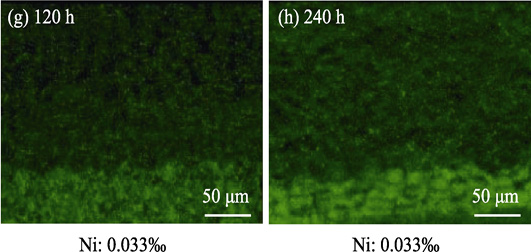
|
|
|
Effects of Impurities on Properties of YSZ Thermal Barrier Coatings
JI Xiaojuan,YU Yueguang,LU Xiaoliang
2020 Vol. 35 (6): 669–674
 Abstract
Abstract(
716 )
 HTML
HTML(
12)
 PDF
PDF(4034KB)(
886
)
Reducing low-melting impurity content in thermal barrier coatings (TBCs) can improve the high temperature stability and service life of coatings. But there is rare quantitative study on the relationship between the low-melting impurity content and coating properties. In the present work, the effect of SiO2, Al2O3, and Fe2O3 impurities on the properties of Yttria-Stabilized Zirconia (YSZ) TBCs prepared by atmospheric plasma spraying was investigated. The samples were prepared with the contents of these impurities being increased gradually from less than 0.01wt% to 1.00wt%. The results demonstrated that those low-melting oxide impurities exhibit a significant effect on thermal conductivity and porosity of the coatings, playing a key role on thermal shock failure. The performance of coatings deteriorated especially significantly when the impurity oxide content is less than 0.2wt%.
|
|
|
Composition, Structure and Properties of the Cr1-xAlxN Hard Films Deposited by Arc Ion Plating
MO Yajie,WANG Minglei,CHEN Weijie,LIN Guoqiang
2020 Vol. 35 (6): 675–681
 Abstract
Abstract(
442 )
 HTML
HTML(
6)
 PDF
PDF(1448KB)(
673
)
Four groups of Cr1-xAlxN films with different Al contents were deposited on ultrafine cemented carbide substrates by arc ion plating, their morphology, composition, phase structure and mechanical property were investigated via field emission scanning electron microscope, X-ray photo electron spectrometry, grazing incidence X-ray diffraction, nanoindenter and scratch tests. The results revealed that the thickness of the films is 1.28, 1.42, 1.64 and 1.79 μm and the aluminum concentration x is 0.41, 0.53, 0.64 and 0.73, respectively, increased with incremental current of Al target. There is a close relationship between phase structure and composition. Films performed single centered cubic B1 structure when x is 0.41, however, demostrated mixed structure of c-(Cr,Al)N and hcp-AlN when x≥0.53. The dimensions of grains obtained a minimum value of 8.9 nm near x=0.64, as Al content increasing, while the variation in hardness followed an increase-decrease pattern, reaching peak values of 35.3 GPa at x=0.64. The films performed pretty adhesion strength and their critical loads were all over 60 N. Based on all test results, the Cr1-xAlxN films exhibited the best combination properties including high hardness of 34.7 GPa, the highest elastic recovery coefficient of 57.4% and the best toughness while x is 0.53.
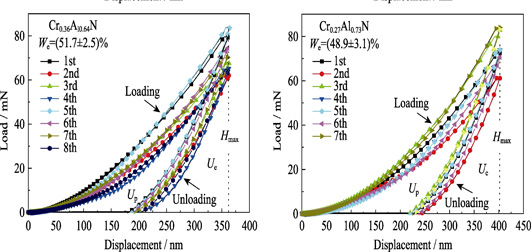
|
|
|
Size Effect on the Interface Modulation of Interlayer and Auger Recombination Rates in MoS2/WSe2 van der Waals Heterostructures
TAN Shilin,YIN Shunda,OUYANG Gang
2020 Vol. 35 (6): 682–688
 Abstract
Abstract(
661 )
 HTML
HTML(
10)
 PDF
PDF(1076KB)(
812
)
To explore the interface engineering on the carrier recombination in two-dimensional (2D) van der Waals (vdW) heterostructures, we developed a theoretical model to address the size-dependent interlayer and Auger recombination rates in MoS2/WSe2 in terms of interface bond relaxation method and Fermi's golden rule. It is found that the Auger recombination lifetime in MoS2/WSe2 increases with increasing thickness due to the weakening of Coulomb interaction between holes and electrons, as well as the Auger recombination rate is much smaller than that of MoS2 and WSe2 units. However, when the thin h-BN layer is introduced into the MoS2/WSe2, the interlayer and Auger recombination rates show opposite trends as the h-BN thickness increases. When the thickness of h-BN reaches 9.1 nm under the condition of 1L MoS2/h-BN/1L WSe2, the Auger recombination rate approaches 5.3 ns -1. These results indicate that the relevant recombination processes can be tuned by interface and dimension. Therefore, our results provide a useful guidance for the optimal design of 2D transition metal dichalcogenides-based optoelectronic nanodevices.

|
|
|
Carbon Nanotube Modified Sepiolite Porous Ceramics for High-efficient Oil/Water Separation
DONG Longhao,ZHANG Haijun,ZHANG Jun,WU Wenhao,JIA Quanli
2020 Vol. 35 (6): 689–696
 Abstract
Abstract(
755 )
 HTML
HTML(
22)
 PDF
PDF(4526KB)(
1049
)
To efficiently recovery oil from oil/water mixed liquid, fibrous sepiolite, polyethylene powder and nickel nitrate was respectively used as raw mateials, carbon source and pore-forming agents, and catalyst precursor to prepare carbon nanotubes (CNTs) modified sepiolite porous ceramics by freeze-drying/catalytic pyrolysis method, and the effects of solid content and pyrolysing temperature on the morphology of the modified porous ceramics were studied. The water contact angle and oil-water separation performance in severly environment such as acid (pH=1), alkali (pH=14), and high (373 K) and low temperature (77 K) were also characterized. The results showed that when the concentration of catalyst precursor solution was 0.5 mol/L, the solid content of sepiolite was 15wt%, the catalytic pyrolysis temperature was 973 K, and the soaking time was 2 h, the as-prepared CNTs modified porous ceramics possessed superhydrophobic/superlipophilic nature, and their maximum adsorption capacity for diesel, paraffin oil, vegetable oil, and vacuum pump oil is respectively 15.7, 20.8, 23 and 25 times of their own weight. The oil flux during the continuous separation process is up to 250 kg·s -1·m -2, and the separation efficiency and selectivity can be maintained without significant decreasing within 5 h.

|
|
|
Adsorption and Separation of CO2/N2 in Metal Organic Frameworks: a Theoretical Investigation
ZHAI Wanru,WANG Jiahui,WANG Maohuai,DU Xuemei,WEI Shuxian
2020 Vol. 35 (6): 697–702
 Abstract
Abstract(
808 )
 HTML
HTML(
24)
 PDF
PDF(2112KB)(
916
)
Metal organic frameworks (MOFs) materials have received extensive attention in capture and separation of CO2. Herein, molecular dynamic simulation (MD) and grand canonical Monte Carlo (GCMC) simulation were used to investigate the process of negative gas adsorption to DUT-49, an MOF, and the effect of structural transition on the CO2/N2 adsorption and separation behavior. Results showed that DUT-49 underwent stable structural deformation at 20-60 MPa, with a transition between open pore (DUT-49-op) and closed pore (DUT-49-cp). Its adsorption capacity decreased with the increase of temperature. DUT-49-cp owned a contractive framework, exhibiting a considerably decreasing adsorption capacity due to reduction of effective adsorption sites. In addition, its selectivity decreased significantly compared with that of DUT-49-op, and decreased with increase of temperature, which is not conducive to gas separation. The present study provides a scientific basis for the development of adsorbent materials.

|
|
|
Synthesis and Photocatalytic Properties of Cucurbit[6]uril/CdS-Ag2S Composite Photocatalyst
PENG Zhangmei,ZHAO Anting,FU Maofen
2020 Vol. 35 (6): 703–708
 Abstract
Abstract(
584 )
 HTML
HTML(
22)
 PDF
PDF(2588KB)(
779
)
CdS is widely used in photocatalytic research due to its unique photoelectrochemical properties. CdS recombination with narrow bandgap semiconductors and organic compounds plays an important role in photocatalyst exploration. In this study, a cucurbit[6]uril (Q[6]) composite and Ag2S-doped cadmium sulfide photocatalyst (Q[6]/CdS-Ag2S) were prepared by chemical precipitation method and their composite was characterized by different methods. The experiment is designed to use visible light as the light source and Rhodamine B as the simulated pollutant. Meanwhile, the effects of Q[6] on the photocatalytic performance of CdSAg2S were investigated. The results showed that the morphology of Q[6]/CdS-Ag2S composite after cucurbit[6]uril recombination was similar to cauliflower, while the particle size become smaller. Catalytic performance of the composite catalyst Q[6]/CdS-Ag2S was significantly higher than that of CdS-Ag2S, the photocatalytic reaction lasts 110 min, showing the catalytic degradation effciency of 92.4% using 15 mg composite catalyst on 100 mL, 6 mg/L Rhodamine B solution.
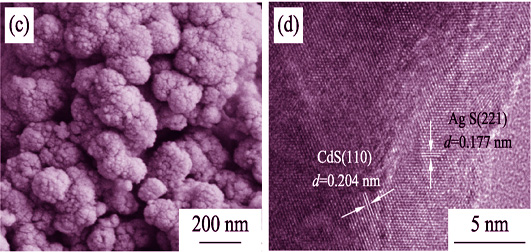
|
|
|
Mg(OH)2 Film on Micro-arc Oxidation Ceramic Coating of AZ31 Magnesium Alloy: Preparation and Corrosion Resistance
WANG Zhihu,ZHANG Jumei,BAI Lijing,ZHANG Guojun
2020 Vol. 35 (6): 709–716
 Abstract
Abstract(
563 )
 HTML
HTML(
11)
 PDF
PDF(7291KB)(
910
)
The micro-arc oxidation (MAO) ceramic coating on AZ31 magnesium alloy was treated by hydrothermal treatment in NaOH solution to study the effect of the concentration of NaOH solution on the microstructure and corrosion resistance of the obtained Mg(OH)2/MAO composite coating, the formation mechanism and the corrosion mechanism of the hydrothermal film was annalysed at the same time. The results showed that MgO in the surface of MAO ceramic layer was partially dissolved during hydrothermal reaction. And the released Mg 2+ was combined with OH - in hydrothermal solution to form Mg(OH)2 nanosheets which deposited on the surface of ceramic layer and inner wall of the pores. With increasing of NaOH concentration of the hydrothermal solution, more Mg(OH)2 formed during hydrothermal reaction and sealed the inherent defects such as pores and cracks in the MAO ceramic layer, which improved the compactness of the coating. In addition, the electrochemical test results demonstrated that the Mg(OH)2/MAO composite coating prepared by MAO and hydrothermal treatment achieved better corrosion resistance than the single MAO ceramic layer, and the corrosion resistance of Mg(OH)2/MAO composite coating increased with the increasing concentration of the hydrothermal solution. And the immersion test showed that Mg(OH)2/MAO composite coating could provide long-term corrosion protection for magnesium alloy.
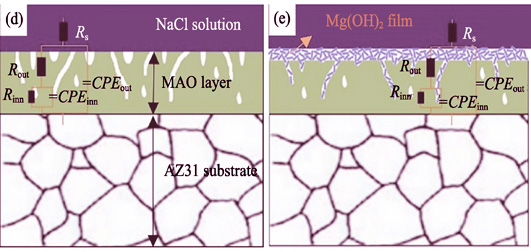
|
|
|
Sawing Angles on Property of Lithium-sulfur Battery Interlayer Prepared with Birch Derived Orientedly Microchannel Biochar
JIANG Hao,WU Hao,HOU Chengyi,LI Yaogang,XIAO Ru,ZHANG Qinghong,WANG Hongzhi
2020 Vol. 35 (6): 717–723
 Abstract
Abstract(
604 )
 HTML
HTML(
28)
 PDF
PDF(7206KB)(
1086
)
Bio-source materials have attracted wide attention due to their rich sources, recyclability, pollution-free and multi-functional properties. Herein, a lithium-sulfur battery interlayer was obtained by slicing the birch at different angles, following with the delignification and carbonization processes. Biochar containing lots of micropores and mesopores shows a specific surface area up to 267.7 m 2/g. The biochar interlayer sawing along 45° achieved the highest electrochemical performances. Based on this biochar interlayer, lithium-sulfur battery exhibits a high initial capacity of 979.4 mAh/g at 0.2C (1C=1650 mA/g) and retains a discharge specific capacity of 625.4 mAh/g after 200 cycles, which degrades only 0.18% per cycle. Furthermore, the hierarchical microchannel and transpiration of birch effectively adsorb polysulfide and reduce the shuttle effect, suggesting that it can be widely employed in commercial lithium sulfur battery.
|
|
|
One-step Solvothermal Synthesis of Strontium-doped Ultralong Hydroxyapatite Nanowires
SUN Tuanwei,ZHU Yingjie
2020 Vol. 35 (6): 724–728
 Abstract
Abstract(
667 )
 HTML
HTML(
25)
 PDF
PDF(4099KB)(
791
)
Ultralong hydroxyapatite nanowires (UHANWs) exhibit great potential in constructing different kinds of biomaterials such as the highly flexible biomedical paper and elastic porous scaffolds for various biomedical applications. Moreover, strontium (Sr), a trace element in human body, plays an important role in bone metabolism. In this study, Sr-doped UHANWs (Sr-UHANWs) with various Sr/(Sr+Ca) molar ratios have been successfully prepared by the one-step oleate precursor solvothermal method. The effects of the Sr/(Sr+Ca) molar ratio on the morphology and crystal phase of the Sr-UHANWs were investigated. The as-prepared Sr-UHANWs exhibit high flexibility and ultralong 1D nanostructure. Moreover, the energy dispersive spectroscopy, X-ray powder diffraction, and Fourier transform infrared spectroscopy of the as-prepared samples reveal that Sr element has been successfully incorporated in UHANWs. The preparation method developed in this work may be suitable for the synthesis of Sr-UHANWs with Sr/(Sr+Ca) molar ratios ranging from 0 to 100 %, which may enlarge the biomedical applications of UHANWs such as bone and teeth defect repair.
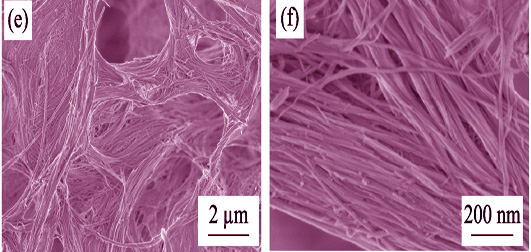
|
|
|
High-purity Ti2AlC Powder: Preparation and Application in Ag-based Electrical Contact Materials
DING Jianxiang,HUANG Peiyan,ZHA Yuhui,WANG Dandan,ZHANG Peigen,TIAN Wubian,SUN Zhengming
2020 Vol. 35 (6): 729–734
 Abstract
Abstract(
545 )
 HTML
HTML(
17)
 PDF
PDF(2257KB)(
781
)
Ag-based electrical contact is the "heart" of low-voltage switch, and the Cd toxicity has long been a haunting problem. It is the research focus of the low-voltage switch to find new environment-friendly electrical contact materials. Starting from the design of reinforcement for Ag-based electrical contact in this work, the high-purity Ti2AlC powder (99.2%) was synthesized by a simple and fast pressureless technique. Ag/Ti2AlC composite electrical contact material was also prepared with homogeneous structure, good bonding between Ag and Ti2AlC particles, high relative density (95.7%), moderate hardness (96HV), satisfactory electrical conductivity (low resistivity of 79.5 nΩ·m), and favorable arc erosion resistance (mass loss of 4.4% after 5610 arc discharging cycles). These excellent structure and properties of Ag/Ti2AlC composite are mainly attributed to the good thermal and electrical conductivity of Ti2AlC and the good wettability between Ag and Ti2AlC. This composite is expected to replace the conventional electrical contact materials in the future.

|
|